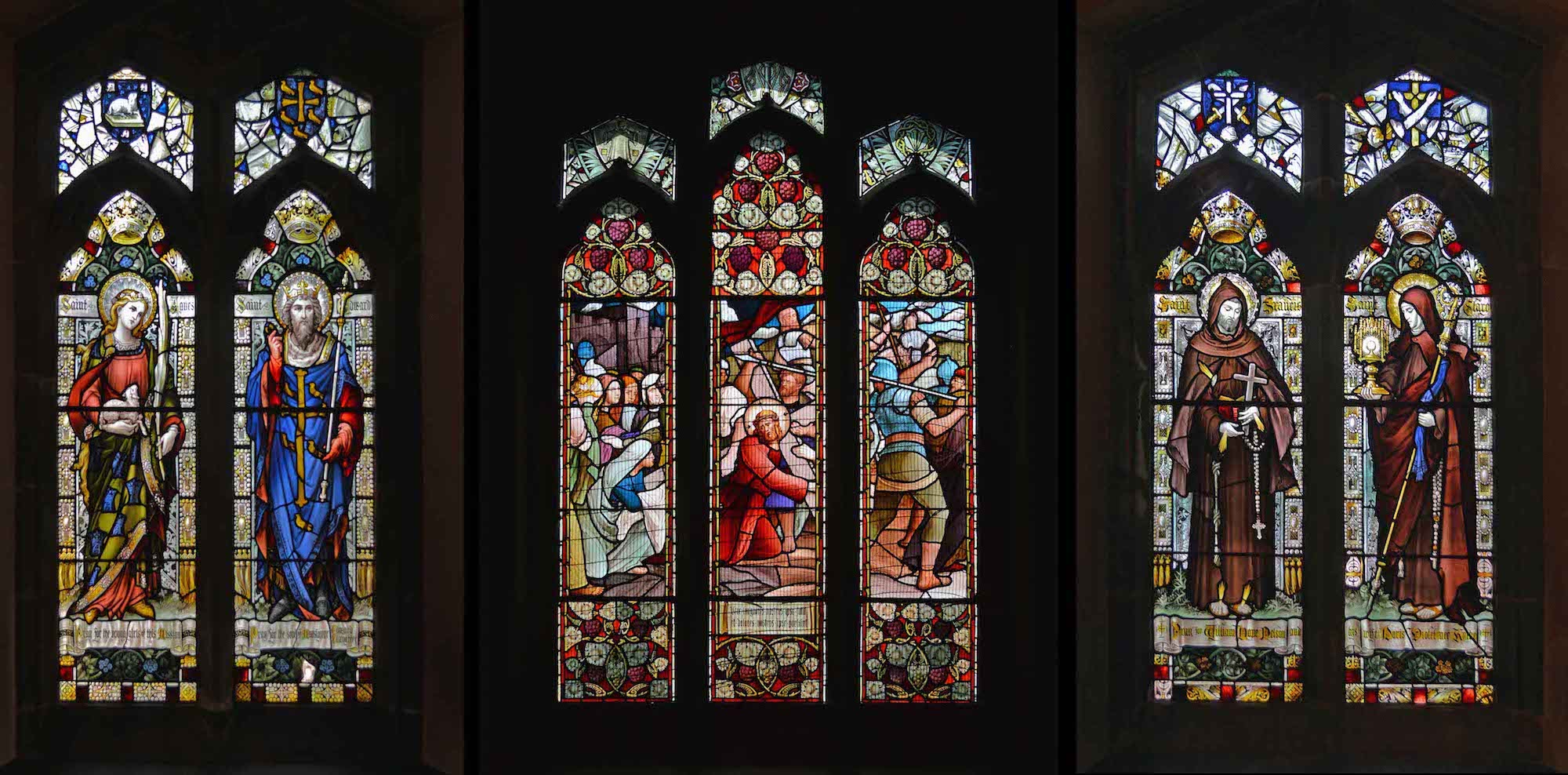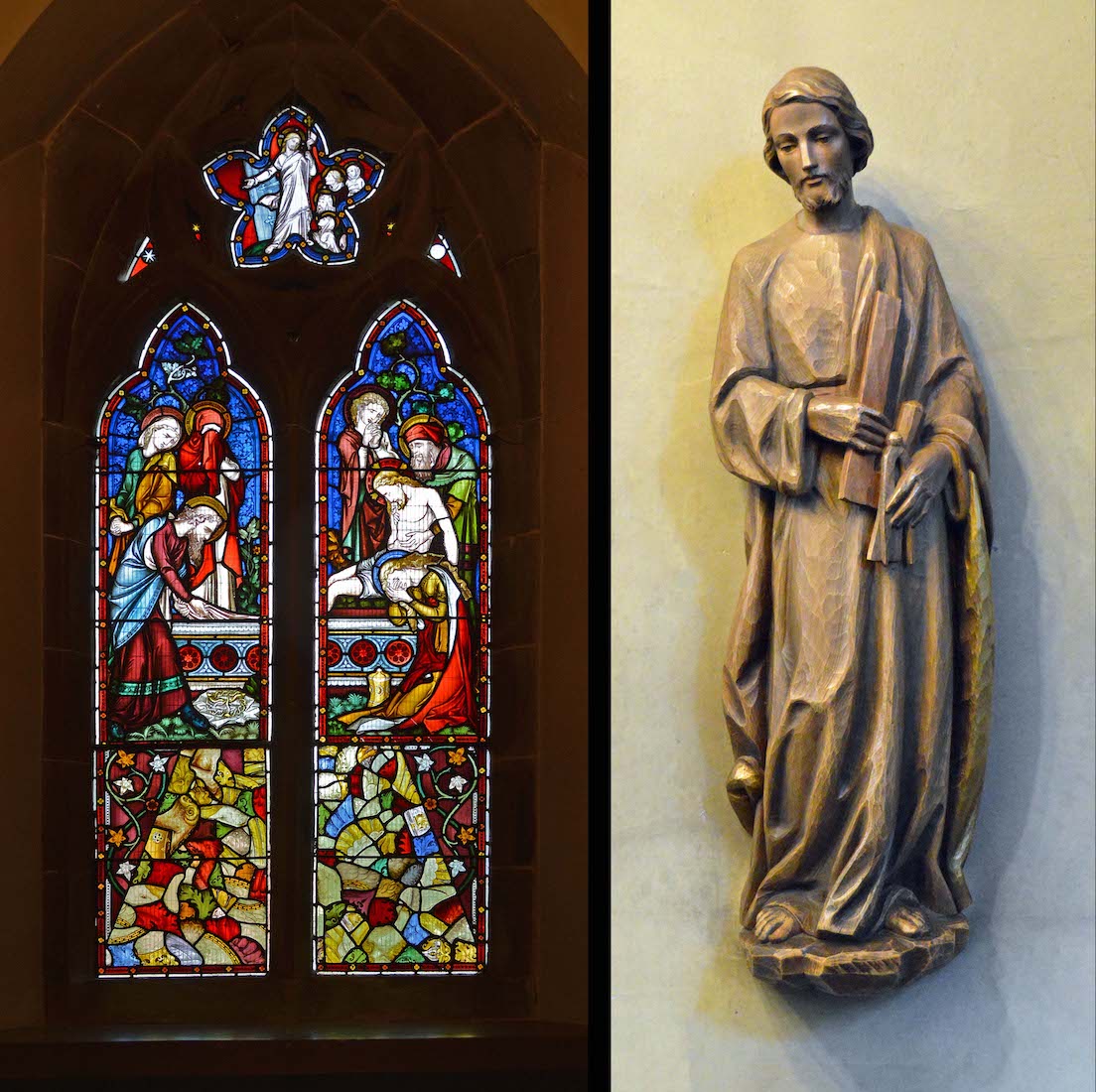
Shown here from left to right are: • St Agnes, and St Edward who was also King; • a triplet of lancets showing Jesus carrying his cross, and talking to the women of Jerusalem; and • St Francis and St Clare. The large central window was initially placed in the East wall behind the altar. The upper part of its originally arched shape had to be removed when it was relocated here. PLAN
22. SOUTH END OF CHAPEL

This cross chapel fronts in a rather curious way onto the side of the altar area of the Blessed Sacrament Chapel. The brass plate seen on the wall at right behind the stand for the hymn numbers, commemorates the lives of members of the Bierne family, who donated the altar rails for the Blessed Sacrament Chapel. The bronze communion rail is in the style of Peter Paul Pugin,brother of E.W. Pugin. It was originally placed across the chancel archway.
23. NAVE
We leave the chapel, and walk to the West end of the nave. High above are the rectangular panels of the arched nave roof. Also high above are round clear clerestory windows letting in much light. To our left and right, Gothic arches and columns march their way towards the front. The columns are topped by capitals carved with slightly stiff arrangements of leaves – typical of the Early Decorated style. Colourful stained glass windows line the side walls. Straight ahead of us is the sanctuary with an interesting rose window. Above the sanctuary arch are four small figures – perhaps icons? PLAN
24. NAVE ROOF
We see here the square panels of the arched nave roof – a ‘wagon roof’ which is common in many Cornish churches. We also notice the floral design structure of the quatrefoil clerestory windows which let light into the nave. Four gilt paintings in the Eastern gable show angels playing musical instruments.
25. WEST NAVE
Looking back towards the West end of the nave, we’ll see the substantial balcony and behind, the clear glass Great West window. An organ console and various music stands are visible on the balcony. Below the balcony is the great West door, and a statue of St Anthony and the Christ Child.
26. THROUGH TO THE TOWER ROOM
We recall that the Cathedral tower and spire stand at the Southwest corner of the nave. From our position here, standing under the balcony, we can see a doorway through to the ground floor room of the tower. Just to the right is an adjacent door leading to stairs to the upper tower and balcony.
27. TOWER ROOM (QUIET ROOM)
The main features of interest in the tower room are the stained-glass windows to the South and to the West. The South window shows the young Jesus in the Temple debating with the elders. The West window shows our Lady of Lourdes appearing to 14-year old·Bernadette Soubirous in 1858.
28. WEST DOOR, ST ANTHONY
Returning to the nave, observe the solid West doors, and the nearby statue of St Anthony of Padua with the Christ Child. St Anthony is often pictured with the infant Jesus. This comes from an old legend which tells how the Christ Child appeared to the elderly saint, alone in his cell.
29. NORTHWEST NAVE
In the Northwest nave, there is a stained-glass window, the main entrance from the cloister, and a statue of Joseph on the wall.
30. WINDOW, JOSEPH
The window shows the disciples of Jesus laying the body of Christ in a tomb. The carved statue is interesting in that it depicts Joseph as the carpenter, holding a set square and carpentry tools. Joseph is often shown holding a flowering sprig, in reference to an old legend.
31. NORTH NAVE WALL
The main feature of this nave wall are the three stained-glass windows, separated by stations of the cross. We notice too the decorations above the windows with heads at the ends. This is the wall that separates the nave from the cloister.
32. STATIONS OF THE CROSS
The stations of the cross depict scenes from the final journey Jesus made to the cross. They are designed as an aid to meditation. Here we see stations VII–III. From the right they show Jesus falling for the first time, Jesus talking to his mother Mary, Simon of Cyrene helping Jesus carry his cross, Veronica wiping the face of Jesus, Jesus falling for the second time. These stations were originally framed and hung in 1906.
33. NORTH NAVE WINDOWS
The windows on this side are not well lit, because of the cloister behind. The windows show pairs of saints. From left: • St Mary Magdalene and St John (the Evangelist); • St Brigid and St Patrick; • St Anna and St Thomas. The nave windows were designed by Hardman and Company of Birmingham.
34. SACRED HEART, CHAPEL
At the end of this wall stands a statue of the Sacred Heart. Beyond this is a front view of the Blessed Sacrament Chapel. On the chapel altar stands a tabernacle containing the reserved Elements of the Eucharist. We shall take a closer look at this shortly.
35. SOUTH NAVE
We now turn to the South wall of the nave. Here there are four more stained-glass windows with Stations of the Cross between. At left is the baptismal font. At right a glass panel separates the tower room.
36. SOUTH NAVE WINDOWS
These windows also depict pairs of saints. From left: • St Richard and St Helena; • St David and St Winefride; • St Hugo and St Margaretta; • St Charles and St Elizabeth of Hungary. It is interesting that the depicted saints are often chosen to correlate with the name(s) of the donors of the windows.
37. SOUTH AISLE AND COLUMNS
The South aisle leads down past the baptismal font, and through to a chapel beyond. We notice that the columns on the left have intricately decorated capitals.
38. WINDOW DECORATIONS
Each of the nave windows has a surmounting stone banner with heads looking out at the ends
39. FONT
The 19th century baptismal font has been reset in the Victorian encaustic tiles that were in the original baptistery. It has several intricately carved faces. Baptism is regarded as an initiation to the Christian life and the Christian church.
40. FONT FACES
The five font faces depict a cross and the symbols of the Four Evangelists. Clockwise from top left we have: a winged ox (St Luke), a floral cross, an angel (St Matthew), an eagle (St John) and a winged lion (St Mark).




















